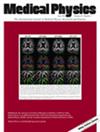Investigation of neuro-vascular reactivity on fMRI study during visual activation in people with multiple sclerosis using EEG and hypercapnia challenge
Abstract
Background
People with multiple sclerosis (MS) exhibit a different pattern of blood oxygenation level-dependent (BOLD) activation on functional magnetic resonance imaging (fMRI) studies when compared to healthy control (HC).
Purpose
The objective of this study is to determine whether observed differences in BOLD activation between people with MS (pwMS) and HC participants are due to the differences of neurovascular coupling, cerebral blood flow (CBF) or actual neuronal activity.
Methods
We investigated the neuronal activation in pwMS (n = 11) and age- and sex-matched HC participants (n = 15) using simultaneous electroencephalogram (EEG) and fMRI measures during a visual task (VT) and hypercapnia condition.
Results
Significant neurovascular coupling is observed in both HC and pwMS. Neuro-vascular coupling ratios are not significantly different between groups. However, we observe significantly lower CBF increase during VT and higher quantitative CBF at a rest state in pwMS than in HC (p < 0.05). From the multiple regression model, in HC group, we found that the BOLD contrast change during VT is best predicted by the EEG power change during VT (Student t-score = 2.64, p = 0.022), and the CBF change during hypercapnia (Student t-score = 2.59, p = 0.024). In pwMS, the BOLD contrast change during VT is negatively predicted by the CBF change during VT (Student t-score = −4.02, p = 0.003).
Conclusion
These findings could explain that BOLD activation in pwMS is mainly determined by the blood flow change during activation rather than the direct neuronal activation measures or hemodynamic vascular reactivity during hypercapnia challenge, suggesting that altered vasodilatory effects in response to task activation in pwMS might be linked to impaired cerebral hemodynamics, possibly leading to the widely observed abnormal BOLD activation in fMRI studies of pwMS.


 求助内容:
求助内容: 应助结果提醒方式:
应助结果提醒方式:


